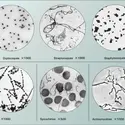EXTRÉMOPHILES
Bibliographie
S. Colliec-Jouault et al., « Exopolysaccharides produced by bacteria isolated from deep-sea hydrothermal vents : New agents with therapeutic potential », in Pathologie Biologie, vol. 52, pp. 127-130, 2004
S. Fujiwara, « Extremophiles : Developments of their special functions and potential resources », in Journal of Bioscience and Bioengineering, vol. 94, pp. 518-525, 2002
C. Leuschner & G. Antranikian, « Heat-Stable Enzymes from extremely thermophilic and hyperthermophilic microorganisms », in World Journal of Microbiology and Biotechnology, vol. XI, pp. 95-114, 1995
J. Guezennec, « Deep-sea hydrothermal vents : a new source of innovative bacterial exopolymers of biotechnological interest ? », in Journal of Industrial Microbiology & Biotechnology, vol. 29, pp. 204-208, 2002
C. MancusoNichols, J. Guézennec& J.-P. Bowman, « Bacterial exopolysaccharides from extreme marine environments with special consideration of the southern ocean, sea ice, and deep-sea hydrothermal vents : a review », in Marine Biotechnology, vol. 7, pp. 253-71, 2005
G. Raguenes et al., « Description of a new polymer-secreting bacterium from a deep-sea hydrothermal vent, Alteromonas macleodii subsp fijiensis, and preliminary characterization of the polymer », in Appl. Environ. Microbiol., vol. LXII, no 1, pp. 67-73, 1996
C. Simon Colin et al., « Biosynthesis of novel medium chain length poly-3-hydroxyalkanoates by Pseudomonas guezennei from various carbon sources, in Reactive and Functional Polymers, vol. 68, série 11, pp. 1534-1541, 2008
R. Weiner, S._Langille & E. Quintero, « Structure, function and immunochemistry of bacterial exopolysaccharides », in Journal of Industrial Microbiology, no 15, pp. 339-346, 1995
P. Zanchetta, N. Lagarde& J. Guézennec, « Systemic effects on bone healing of a new hyaluronic acid-like bacterial exopolysaccharide », in Calcified Tissue International, vol. 73, pp. 232-236, 2003.
La suite de cet article est accessible aux abonnés
- Des contenus variés, complets et fiables
- Accessible sur tous les écrans
- Pas de publicité
Déjà abonné ? Se connecter
Écrit par
- Jacques DIETRICH : directeur de l'Ifremer, centre de Sète
- Jean GUEZENNEC : responsable du programme Prospection et valorisation des ressources biologiques, Ifremer, centre de Brest
Classification
Pour citer cet article
Jacques DIETRICH et Jean GUEZENNEC. EXTRÉMOPHILES [en ligne]. In Encyclopædia Universalis. Disponible sur : (consulté le )
Autres références
-
ARCHÉOBACTÉRIES ou ARCHÉES
- Écrit par Patrick FORTERRE
- 2 138 mots
Lesarchées halophiles (qui aiment le sel) sont des micro-organismes aérobies stricts dont la particularité est de vivre dans les milieux proches de la saturation en sel (lacs salés, marais salants). Ils maintiennent leur pression osmotique interne en accumulant des concentrations équivalentes de chlorure... -
BACTÉRIES
- Écrit par Jean-Michel ALONSO, Jacques BEJOT, Patrick FORTERRE
- 11 052 mots
- 3 médias
Certaines bactéries ayant réussi à s'adapter à des milieux très inhospitaliers sont dites extrémophiles. On distingue chez elles des halophiles, dont certaines exigent des concentrations en sodium atteignant 3 × molaires, les acidophiles, adaptées aux pH très bas (inférieur à 3), et inversement...
Voir aussi
- POLYESTERS
- ENZYMES
- AMYLASES
- MICRO-ORGANISME
- ORGANOCHLORÉS COMPOSÉS
- LESSIVES
- PAPETERIE
- PSYCHROPHILES
- ACIDOPHILES
- ALCALIPHILES
- CHIMIQUES INDUSTRIES
- BLANCHIMENT
- LAVAGE
- BIODÉGRADABILITÉ
- PROFONDEURS OCÉANIQUES, biologie
- CELLULASES
- POLYSACCHARIDES ou POLYHOLOSIDES
- BAROPHILES
- POLYHYDROXYALCANOATES
- EXOPOLYSACCHARIDES
- BIOSYNTHÈSES
- LIPASES
- DÉCONTAMINATION
- THERMOPHILES
- LCR (ligase chain reaction)
- ENZYMOLOGIE INDUSTRIELLE
- PROTÉASES
- PÂTE À PAPIER
- GERMES, biologie
- HYDROTHERMALISME OCÉANIQUE ET SOURCES HYDROTHERMALES SOUS-MARINES
- HALOPHILES



